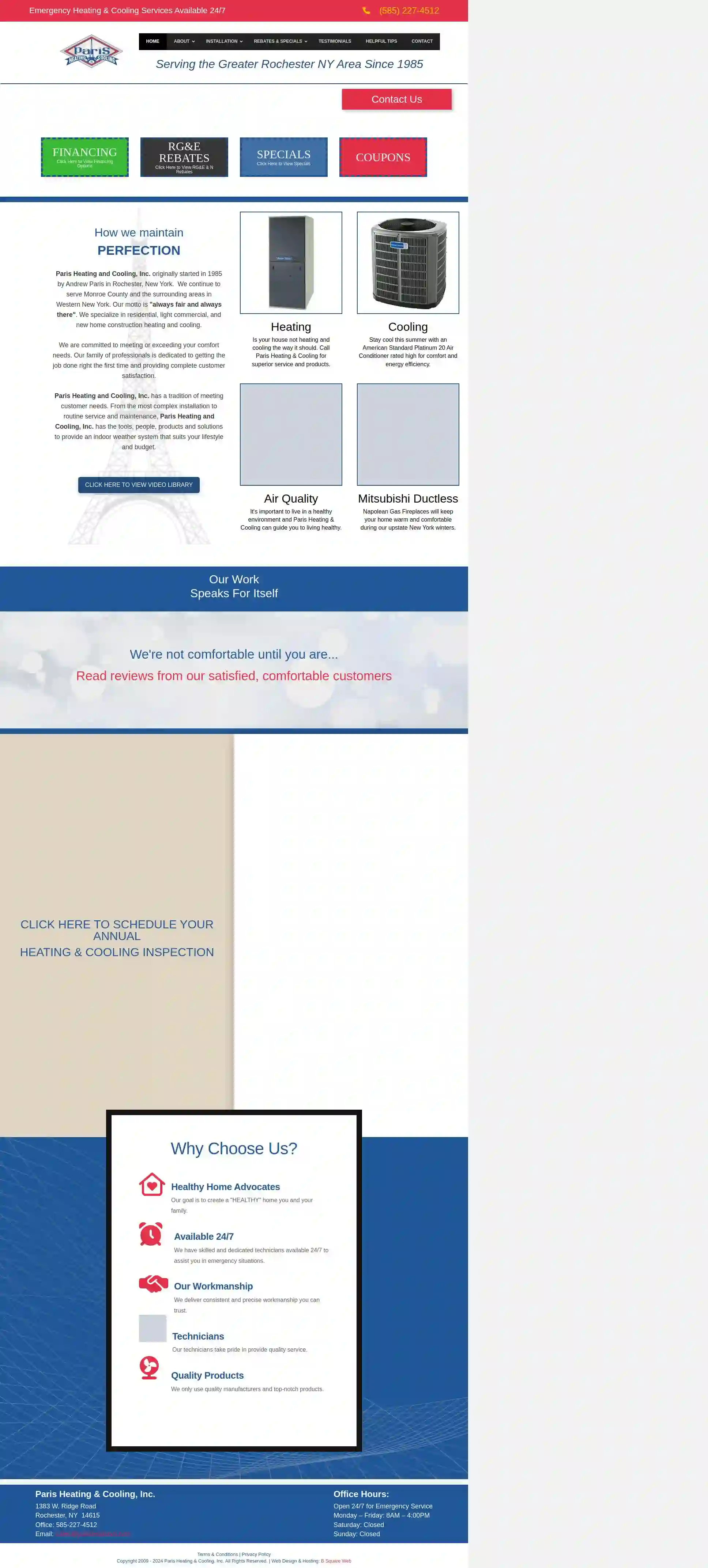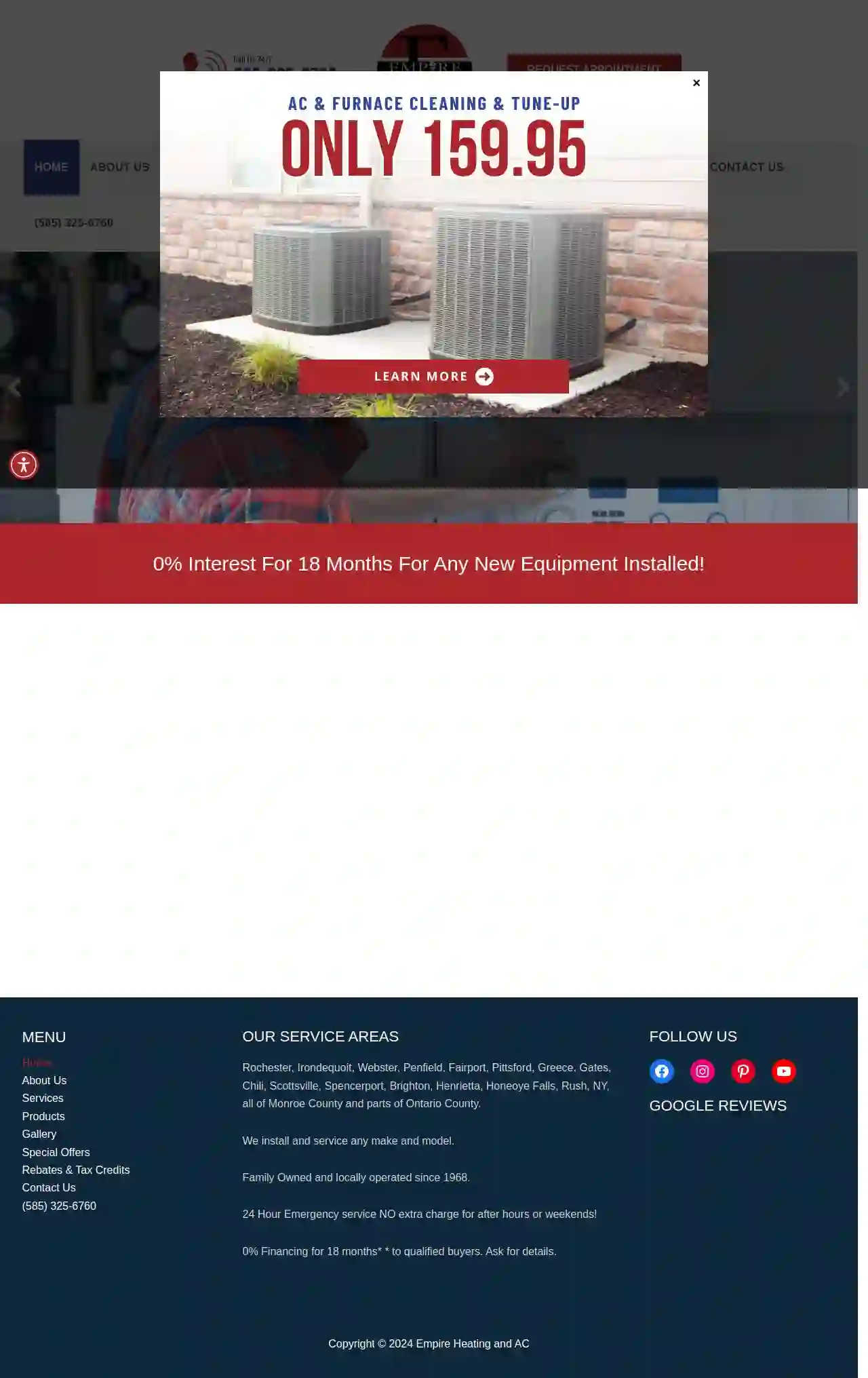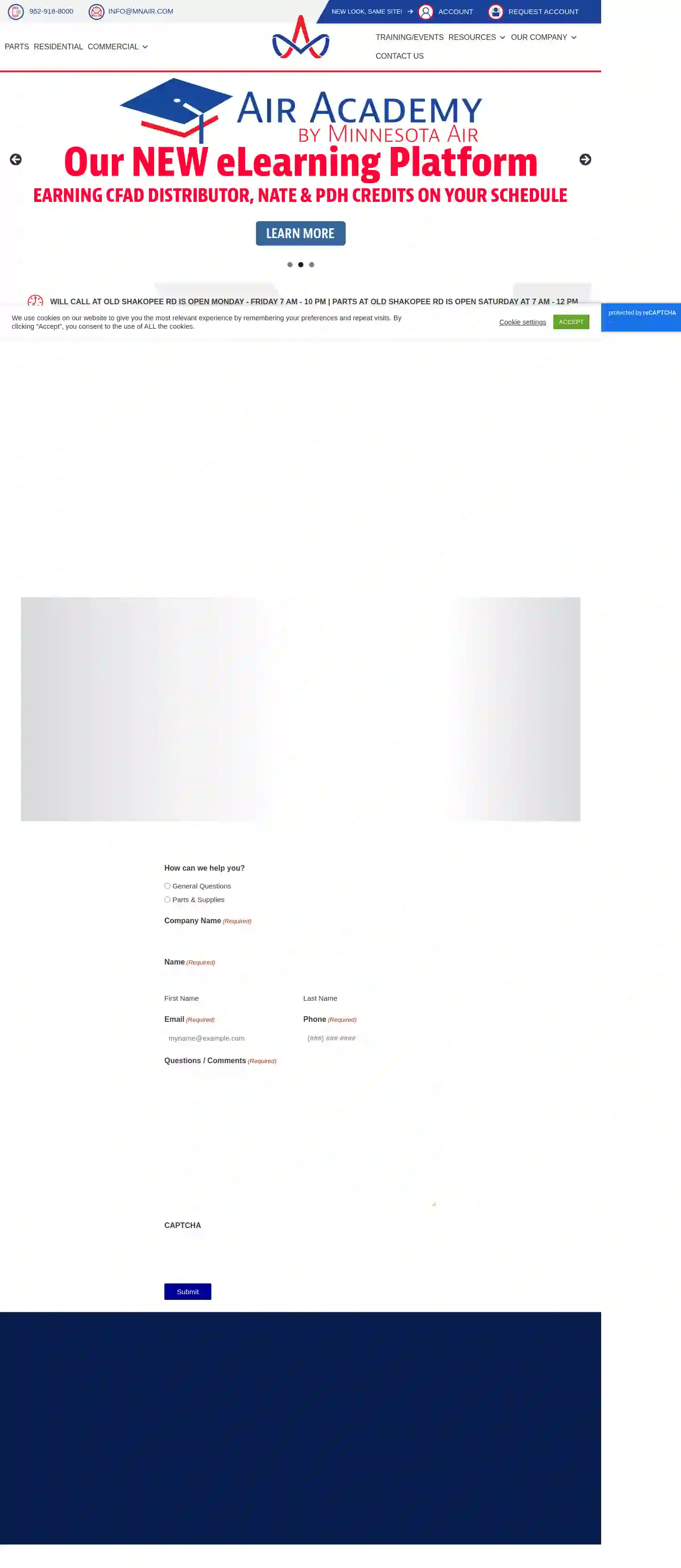Commercial HVAC South St. Paul
Find Commercial HVAC Systems in South St. Paul
Receive 3 FREE Commercial HVAC quotes for your project today! Compare profiles, reviews, accreditations, portfolio, etc... and choose the best deal.

Total Comfort
4.98818 7th Ave N, Golden Valley, 55427, USAt Total Comfort, we pride ourselves on exceeding customer expectations with our service, education and prices. We offer top notch repair, replacement and maintenance services for homes in and around the area. Total Comfort is proud to be a Home Depot partner in . Looking for a Heating & Cooling company you can trust? Call Total Comfort at (763) 307-4954 today!
- Services
- Why Us?
- Accreditations
- Gallery
Get Quote
Trident HVAC, LLC
1462 Lyell Ave. Suite 2, Rochester, 14606, USAt Trident, our commitment to excellence is at the heart of everything we do. Our team of highly skilled technicians is driven by a passion for creating comfortable, efficient, and safe environments. Whether it's a cozy home, bustling commercial space, or complex industrial facility, we approach every project with the same level of dedication and attention to detail. We are a family-owned and operated business with over 30 years of experience, providing customized solutions for all your HVAC, plumbing, and refrigeration needs. Our team is dedicated to providing exceptional service and support, and we are committed to being your reliable partner for all your indoor environment needs.
- Services
- Why Us?
- Gallery
Get Quote
Paris Heating and Cooling
4.9133 reviews1383 W. Ridge Road, Rochester, 14615, US- Services
- Why Us?
- Gallery
Get Quote
Midland Heating & Air Conditioning
4.713 reviews4804 Park Glen Rd, Minneapolis, 55416, USFor over six decades, Midland Heating & Cooling has been providing the absolute best HVAC services to thousands of home owners across the great state of Minnesota. Our service area includes Minneapolis, St. Paul, Richfield, Edina, St. Louis Park, Golden Valley, Bloomington, Hopkins, Eden Prairie, Mendota Heights, Eagan and most other Twin Cities communities as well. Clients across these regions have come back to us time and time again because we have a reputation for taking care of our customers like no other company can. Our goal is complete customer satisfaction, and it is something we have remained true to since day one. From our free in-home estimates to our tune-up specials and military discounts, we do all we can to give our customers a budget-friendly and completely outstanding experience.
- Services
- Why Us?
- Gallery
Get Quote
Empire Heating & Air Conditioning
4.591 reviews469 East Ridge Road, Rochester, 14621, USEmpire Heating & Cooling is your trusted partner for all your home comfort needs in Rochester, NY. We are a family-owned and operated business with over 20 years of experience providing exceptional service to our customers. Our team of highly skilled technicians is dedicated to delivering reliable, efficient, and affordable solutions for your heating, cooling, and plumbing needs. We offer a wide range of services, including furnace and air conditioning installation, repair, and maintenance, as well as indoor air quality solutions, electrical repair, chimney and masonry services, and more. We are committed to providing our customers with the highest level of customer service and satisfaction.
- Services
- Why Us?
- Accreditations
- Our Team
- Testimonials
- Gallery
Get Quote
Horwitz, LLC.
3.332 reviewsMinneapolis, USHorwitz LLC is a full service specialty contractor providing design-build, installation and ongoing support for the HVAC, plumbing, and electrical markets in the Twin Cities. With a legacy of 100 years, we have a proven track record of delivering high-quality services to our clients. Our team of professionals has over 0 years of experience and has achieved 0 hours without a lost time injury. We take pride in our core values of safety, quality, and customer satisfaction. Our services include design-build, fabrication, sheet metal, electrical, HVAC piping, building automation, industrial ventilation, high purity process piping, mechanical insulation, and millwrights. We also offer service and preventative maintenance to ensure our clients' systems are running efficiently and effectively.
- Services
- Why Us?
- Gallery
Get Quote
High Performance Heating and Cooling
4.8519 reviews2350 Brighton Henrietta Townline Road, Rochester, 14623, USHigh Performance Heating & Air Conditioning is a leading provider of residential and commercial HVAC services in Rochester, NY. With a commitment to providing exceptional customer service and unparalleled expertise, our team of professionals is dedicated to ensuring your home or business stays comfortable and efficient. From AC installation and maintenance to heating repair and installation, we offer a wide range of services to meet your unique needs. Contact us today to schedule service and experience the High Performance difference!
- Services
- Why Us?
- Accreditations
- Our Team
- Testimonials
- Gallery
Get Quote
Minnesota Air, Inc. - Headquarters
4.648 reviews6901 W Old Shakopee Rd, Bloomington, 55438, USMinnesota Air is a leading distributor of HVAC parts and supplies, serving residential, commercial, and industrial customers throughout the Twin Cities area. With a vast inventory of in-stock products and a team of experienced professionals, we provide fast, reliable service and expert technical support. Our commitment to customer satisfaction is unwavering, and we strive to be the trusted partner for all your HVAC needs. We offer a wide ranges of products, including Carrier RTUs, humidifiers, and systems. We also provide 24/7 emergency parts service for those unexpected breakdowns.
- Services
- Why Us?
- Gallery
Get Quote
Crossfield Heating & Air Conditioning
4.9775 reviewsWebster, NY, 44 Donovan Street, 14580, USCrossfield Heating & Cooling is a trusted heating and cooling expert in Rochester, NY, serving the area for over 30 years. We pride ourselves on providing timely, professional, and helpful service 24 hours a day. Our highly skilled, trained technicians take great pride in their work and careers. Our knowledgeable, empowered office team members will take care of you quickly - without red tape. We will take the time to listen and communicate clearly so you are comfortable and informed in your decisions. We will provide information and advice so you can determine the best energy and comfort solution for your home and budget. We will never just "install a box." When the "cry for help" goes out, you'll know we care.
- Services
- Why Us?
- Gallery
Get Quote
Peak Heating & Cooling Inc.
4.9170 reviews7801 Park Drive Suite B, Chanhassen, 55317, USPeak Heating & Cooling Inc. is a full-service HVAC company. When it comes to dispatching a technician for your furnace, AC, heat pump, boiler, or mini-split repair or replacement, we only send the best. We proudly service Chanhassen, Eden Prairie, and Chaska. So, when you ask Google for a “good heating or AC company near me” you know you’ve come to the right place. To get a quote on your ac or air conditioning repair, call (952) 401-1195. Peak services all major HVAC brands brands including Coleman, Carrier, Bryant, Trane, Lennox, Rheem, Ruud, York, and American Standard.
- Services
- Why Us?
- Gallery
Get Quote
Over 15,611+ HVAC Businesses on our directory
Our HVAC companies operate in South St. Paul and surrounding areas!
HVACCompaniesHub has curated and vetted the Best HVAC Contractors in and around South St. Paul. Find the most reliable business today.
Frequently Asked Questions about Commercial HVAC
- Age: If your system is 15-20 years old or older, it is likely to be less efficient and more prone to breakdowns.
- Frequent Repairs: If you're constantly calling for repairs, a new system may be more cost-effective in the long run.
- Rising Energy Bills: An inefficient system can lead to increased energy consumption.
- Inconsistent Temperatures: If some areas of your building are too hot or too cold, an upgrade might be necessary.
- Poor Indoor Air Quality: A new system can improve ventilation, filtration, and humidity control to address indoor air quality issues.
- Refrigerant Changes: If your system uses an older type of refrigerant, an upgrade might be required to switch to an environmentally friendly refrigerant.
- Upgrade to High-Efficiency Equipment: Invest in energy-efficient HVAC equipment.
- Optimize Thermostat Settings: Use a programmable or smart thermostat to control temperatures and reduce HVAC usage.
- Regular Maintenance: Schedule preventative maintenance twice a year.
- Seal Air Leaks and Improve Insulation: Ensure proper insulation in the building envelope and seal any air leaks.
- HVAC Zoning: Divide your building into separate zones with dedicated temperature controls.
- Regularly Clean or Replace Air Filters: Keep air filters clean to improve airflow and energy efficiency.
- Ventilation: Implement ventilation strategies and save energy.
- Employee Awareness: Encourage energy-saving practices among your employees, such as turning off lights and equipment when not in use.
- Building Size and Layout: The size and configuration of your business space.
- Business Type: Different businesses have different HVAC requirements.
- Budget: Set a realistic budget for your HVAC project.
- Energy Efficiency: Look for systems with high SEER and AFUE ratings.
- Climate: Consider your local climate conditions.
- Indoor Air Quality Needs: Take into account any indoor air quality standards.
When should I consider upgrading my commercial HVAC system?
How can I save money on commercial HVAC costs?
What is a Variable Refrigerant Flow (VRF) system?
How do I choose the right HVAC system for my business?
When should I consider upgrading my commercial HVAC system?
- Age: If your system is nearing the end of its typical lifespan, it is likely to be less efficient and more prone to breakdowns.
- Frequent Repairs: If you're constantly calling for repairs, a new system may be more cost-effective in the long run.
- Rising Energy Bills: An inefficient system can lead to increased energy consumption.
- Inconsistent Temperatures: If some areas of your building are too hot or too cold, an upgrade might be necessary.
- Poor Indoor Air Quality: Upgrade to an HVAC system with enhanced filtration for improved IAQ.
- Refrigerant Changes: If your system uses an outdated refrigerant that is being phased out, an upgrade might be required to switch to an environmentally friendly refrigerant.
How can I save money on commercial HVAC costs?
- Upgrade to High-Efficiency Equipment: Invest in energy-efficient HVAC equipment.
- Optimize Thermostat Settings: Use a programmable or smart thermostat to schedule temperature changes and minimize energy waste.
- Regular Maintenance: Schedule preventative maintenance to keep the system operating at its best.
- Seal Air Leaks and Improve Insulation: Ensure proper insulation in the building envelope and seal any air leaks.
- HVAC Zoning: Divide your building into separate zones with dedicated temperature controls.
- Regularly Clean or Replace Air Filters: Keep air filters clean to improve airflow and energy efficiency.
- Ventilation: Implement ventilation strategies and save energy.
- Employee Awareness: Encourage energy-saving practices among your employees, such as turning off lights and equipment when not in use.
What is a Variable Refrigerant Flow (VRF) system?
How do I choose the right HVAC system for my business?
- Building Size and Layout: The size and configuration of your business space.
- Business Type: Different businesses have different HVAC requirements.
- Budget: Determine your budget and stick to it.
- Energy Efficiency: Look for systems with high SEER and AFUE ratings.
- Climate: Consider your local climate conditions.
- Indoor Air Quality Needs: If you have specific air quality requirements, consider systems with advanced filtration.